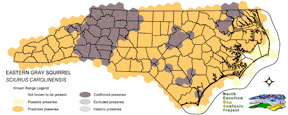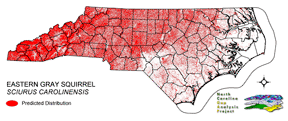
| Taxa: |
| Order: |
| Family: |
| Mammalia |
| Rodentia |
| Sciuridae |
| NatureServe Global Rank: |
| NatureServe State (NC) Rank: |
| G5 |
| S5 |
| Federal Status: |
| NC State Status: |
| --- |
| --- |


| Land Unit |
| US Fish & Wildlife Service |
| US Forest Service |
| US National Park Service |
| US Department of Defense |
| NC State Parks |
| NC University System |
| NC Wildlife Res. Com. |
| NC Forest Service |
| NC Div. of Coastal Mgmt. |
| Local Governments |
| Non-Governmental Org. |
| Other Public Lands |
| Private Lands |
| GAP Status 1-2 |
| All Protected Lands |
| Statewide |
| Hectares |
| 8,775.27 |
| 394,547.31 |
| 22,664.97 |
| 109,354.95 |
| 25,605.54 |
| 4,008.69 |
| 38,497.23 |
| 4,776.69 |
| 893.79 |
| 9,575.55 |
| 10,339.02 |
| 2,164.50 |
| 4,792,354.47 |
| 215,905.26 |
| 628,643.82 |
| 5,423,557.98 |
| Acres |
| 21,684.16 |
| 974,947.45 |
| 56,006.35 |
| 270,221.91 |
| 63,272.65 |
| 9,905.69 |
| 95,128.71 |
| 14,611.56 |
| 2,208.60 |
| 23,661.69 |
| 25,548.27 |
| 5,348.59 |
| 11,842,163.49 |
| 536,321.52 |
| 1,556,220.51 |
| 13,404,709.13 |
| % of Dist. on |
| Prot. Lands |
| 1.4 % |
| 62.8 % |
| 3.5 % |
| 17.4 % |
| 4.1 % |
| 0.6 % |
| 6.1 % |
| 0.8 % |
| 0.1 % |
| 1.5 % |
| 1.5 % |
| 0.2 % |
| < 0.1 % |
| 34.3 % |
| ----- |
| ----- |
| % of Dist. on |
| All Lands |
| 0.2 % |
| 7.3 % |
| 0.4 % |
| 2.0 % |
| 0.5 % |
| < 0.1 % |
| 0.7 % |
| < 0.1 % |
| < 0.1 % |
| 0.2 % |
| 0.2 % |
| < 0.1 % |
| 88.4 % |
| 4.0 % |
| ----- |
| ----- |
|
NATURE SERVE GLOBAL HABITAT COMMENTS: Prefers mature deciduous and mixed forests with abundant supplies of mast (e.g., acorns, hickory nuts). A diversity of nut trees is needed to support high densities. Also uses city parks and floodplains. Seldom far from permanent open water. In southern Alabama, narrow bands of hardwoods along ephemeral streams were an important component of the habitat in even-aged pine and mixed pine-hardwood stands (Fischer and Holler 1991). Rests in tree cavity or leaf nest; leaf nests apparently are made primarily by dispersing juveniles 18-19 weeks old. Nests in tree cavities or in leaf nests, usually 25 feet or more above ground. Most winter-spring litters are born in tree cavities, most spring-summer litters in leaf nests (Teaford 1986). Cavities suitable for nesting are dry, 15-25 cm in diameter, 40-50 cm deep, with an entrance hole about 8 cm in diameter (Teaford 1986). Females may move young from tree cavity nest to leaf nest, possibly to escape fleas. |
| Code | Name | Description | NC Natural Heritage Program Equivalent |
| 17 | Maritime Forests and Hammocks | Maritime forests and woodlands dominated by live or sand laurel oak. Estuarine Fringe forests dominated by loblolly pine. | Coastal Fringe Evergreen Forest, Maritime Deciduous Forest, Maritime Deciduous Forest |
| 50 | Coastal Plain Mixed Bottomland Forests | Includes forests dominated by a variety of hardwood species, including sweetgum, cottonwood, red maple. | Coastal Plain Bottomland Hardwood (in part), Coastal Plain Levee Forest |
| 49 | Coastal Plain Oak Bottomland Forest | Bottomland forests dominated by deciduous oak alliances. Oaks represented can include swamp chestnut, cherrybark, willow, and/or overcup oak. Inclusions of loblolly pine temporarily flooded forests occur in patches. Hydrology is temporarily to seasonally flooded. | Coastal Plain Bottomland Hardwoods (in part) blackwater subtype, brownwater subtype |
| 385 | Oak Bottomland Forest and Swamp Forest | The swamp chestnut oak, cherrybark oak, shumard oak and sweetgum alliance is one representative. Other alliances are dominated by water, willow, and overcup oaks. Swamp forests can be dominated by sweetgum, red maple, and black gum being dominant. Loblolly can occur in combination with sweetgum and red maple, or with tulip poplar. Includes saturated and semi- to permanently flooded forests in the mountains. | Piedmont/Mountain Bottomland Forest, Piedmont/Mountain Swamp Forest |
| 63 | Coastal Plain Mesic Hardwood Forests | Beech dominated forests with white oak and northern red oak as possible co-dominants. Dry-mesic to mesic forests on slopes and small stream bottoms in the coastal plain. | Mesic Mixed Hardwood Forest, Basic Mesic Forests |
| 138 | Coastal Plain Dry to Dry-Mesic Oak Forests | Oak dominated forests of the coastal plain. Includes white oak forests with water oak or northern red oak and hickories as co-dominants. | Dry Mesic Oak Hickory Forest, Basic Oak Hickory Forest, Dry Oak Hickory Forest |
| 46 | Xeric Oak - Pine Forests | Mixed forest dominated by yellow pines with white or northern red oaks co-dominating. | Pine Oak Heath |
| 232 | Xeric Pine-Hardwood Woodlands and Forests | Mixed forest dominated by yellow pines with drier oaks including southern red, post, and chestnut oaks. | Dry Oak Hickory Forest |
| 230 | Piedmont Mesic Forest | American Beech - Red Oak - White Oak Forests. | Mesic Mixed Hardwood |
| 384 | Piedmont/Mountain Mixed Bottomland Hardwood Forests | Includes temporarily to seasonally forests dominated by hardwood species. Hardwoods include sweetgum, red maple, sycamore which co-occur in a mosaic of bottomland and levee positions. Includes alluvial hardwood forests in the mountains. Hemlock and white pine may occur as inclusions, but are generally mapped separately. | Piedmont/Mountain Alluvial Forest, Piedmont/Mountain Levee Forest |
| 383 | Piedmont Mixed Successional Forest | Generally loblolly mixed with successional hardwoods. Sweetgum, tulip poplar and red maple are common co-dominants in these successional forests. | No equivalent |
| 228 | Piedmont Dry-Mesic Oak and Hardwood Forests | Primarily oak dominated forests, white oak is often dominant, with co-dominants including . Also represented by sweetgum and tulip poplar dominated forests. | Dry Mesic Oak Hickory Forest, Basic Oak Hickory Forest, Dry Oak Hickory Forest |
| 382 | Dry Mesic Oak Pine Forests | Mixed forests of the coastal plain and piedmont. Includes loblolly pine with white, southern red and/or post oak and loblolly with water oak. On basic sites of the piedmont, eastern red cedar may co-occur with post, black, and blackjack oaks. | Dry Mesic Oak Hickory Forest, Xeric Hard Pan Forest, Chestnut Oak Forest, Dry Mesic Oak Hickory Forest, Dry Oak Hickory Forest |
| 226 | Piedmont Xeric Woodlands | Generally post and blackjack oak dominated woodlands. White ash and pignut hickory can be found in combination with Eastern red cedar on glades. | Xeric Hardpan Forest |
| 36 | Successional Deciduous Forests | Regenerating deciduous trees with a shrub stature. Commonly dominated by sweetgum, tulip poplars and maples. | No equivalent |
| 202 | Residential Urban | Includes vegetation interspersed in residential areas. Includes lawns, mixed species woodlots, and horticultural shrubs. Vegetation accounts for between 20 - 70% of the cover. | No equivalent |
| 203 | Urban Low-Intensity Developed | Highly developed areas with vegetation accounting for < 20% of the cover. | No equivalent |
| 522 | Northern Hardwoods | High Elevation forests including yellow birch, American beech, and yellow buckeye. Includes forests with Hemlock and Yellow Birch. | Northern Hardwoods Forest, Boulderfield Forest |
| 525 | Appalachian Oak Forest | A variety of oak forest types including Black, White, Scarlet Oaks in dry to mesic situations. Includes forests historically co-dominated by American Chestnut. | High Elevation Red Oak Forest, Montane White Oak Forest |
| 526 | Appalachian Cove Forest | Mixed Mesophytic forests of the mountains. Includes tuliptree, basswood, yellow buckeye and surgar maple. This class is mapped to include cove forests dominated or co-dominated by hemlock. | Rich Cove Forest, Acidic Cove Forest |
| 529 | Appalachian Xeric Mixed Forest | Mixed forests with Virginia, Shortleaf, Eastern White Pine, Table Mountain and Pitch pines in combination with xeric oak species. Oaks include, white, Southern Red, black, and rock chestnut. | Pine Oak Heath |
| 530 | Appalachian Xeric Deciduous Forest | Deciduous forests in the mountains dominated by Xeric Oak species. Species include, white, Southern red, black, and rock chestnut. | High Elevation Red Oak Forest, Montane White Oak Forest |
|
Pack, J.H. Mosby and P. Siegal. 1967. Influence of social hierarchy on gray squirrel behavior. J. Wildl. Mgmt. 31(4):720-728.
Doebel, J., and B. McGinnes. 1974. Home range and activityof a gray squirrel population. J. Wildl. Mgmt. 38(4):860-67. Flyger, V., and J. E. Gates. 1982. Fox and gray squirrels. Pages 209-229 in J. A. Chapman and G. A. Feldhamer, editors. Wild mammals of North America:biology, managment, and economics. Johns Hopkins Univ. Press, Baltimore. Moncrief, N. D. 1993. Geographic variation in fox squirrels (SCIURUS NIGER) and gray squirrels (S. CAROLINENSIS) of the lower Mississippi River valley. J. Mamm. 74:547-576. Uhlig, H.G. 1955. The gray squirrel -- its life history, ecology, and population characterics in West Virginia. 175 pp. Koprowski, J. L. 1994. Sciurus carolinensis. Am. Soc. Mamm., Mammalian Species No. 480:1-9. Hafner, M. S., L. J. Barkley, and J. M. Chupasko. 1994. Evolutionary genetics of New World tree squirrels (tribe Sciurini). J. Mamm. 75:102-109. Usher, M. B., T. J. Crawford, and J. L. Banwell. 1992. An American invasion of Great Britain:the case of the native and alien squirrel (SCIURUS) species. Conservation Biology 6:108-115. Williamson, S. J. No date. Forester's guide to wildlife habitat improvement. Cooperative Extension Service, Univ. of New Hampshire. 56 pp. Baker, R.H. 1959. The gray squirrel-past, present, and future, pp. 390-392. in V. Flyger, Ed. Symposium on the graysquirrel. Maryland Dept. Res. and Ed., Contr. No. 162, pp. 356-407. Flyger, V. F. 1959. A comparison of methods for estimating squirrel populations. J. Wildl. Manage. 23:220-223. Longley, W.H. and ? 1963. Minnesota gray and fox squirrels. Am. Midl. Nat. 69(1):82-89. Barkalow, F.S. and M. Shorten. 1973. The World of the Gray Squirrel. J.B. Lippincott Co. Philadelphia, PA. 160 pp. Banfield, A.W.F. 1974. The mammals of Canada. University of Toronto Press, Toronto. Godin, A.J. 1977. Wild Mammals of New England. Johns Hopkins University Press, Baltimore. 304 pp. Hamilton, William J., Jr., and John O. Whitaker, Jr. 1979. Mammals of the eastern United States. Cornell Univ. Press, Ithaca, New York. 346 pp. Hall, E. R. 1981. The Mammals of North America. Second edition. 2 Volumes. John Wiley and Sons, New York, New York. Schwartz, Charles W., and Elizabeth R. Schwartz. 1981. The wild mammals of Missouri. University of Missouri Press, Columbia. 356 pp. Baker, Rollin H. 1983. Michigan mammals. Michigan State University Press. 642 pp. Teaford, J. W. 1986. Squirrel nest boxes. Section 5.1.1, US Army Corps of Engineers Wildlife Resources Management Manual. Tech. Rep. EL-86-11. Waterways Expt. Station, Vicksburg, Mississippi. 15 pp. Teaford, J. W. 1986. Eastern gray squirrel (SCIURUS CAROLINENSIS). Section 4.7.1, US Army Corps of Engineers Wildlife Resources Management Manual. Tech. Rep. EL-86-6. Waterways Expt. Station, Vicksburg, Mississippi. 36 pp. Gurnell, J. 1987. The natural history of squirrels. Facts on File Publications, New York. 201 pp. Nixon, C. M., and L. P. Hansen. 1987. Managing forests to maintain populations of gray and fox squirrels. Illinois Dept. Conserv. Tech Bull. 5. 39 pp. Fischer, R. A., and N. R. Holler. 1991. Habitat use and relative abundance of gray squirrels in southern Alabama. J. Wildl. Manage. 55:52-59. |
For more information please contact them at:
NC-GAP Analysis Project
Dept. of Zoology, NCSU
Campus Box 7617
Raleigh, NC 27695-7617
(919) 513-2853
www.basic.ncsu.edu/ncgap